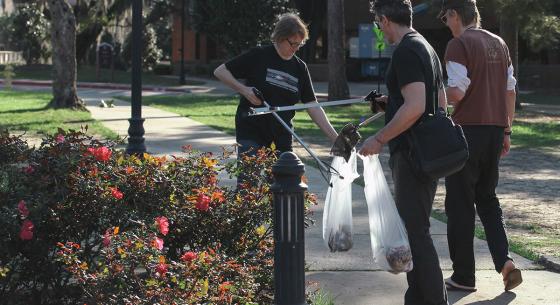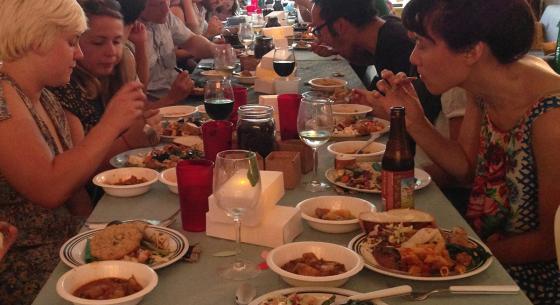Activating the Senses with SHORE
Editor's Note: Last week, I sat down with artistic collaborators Emily Johnson and James Everest to talk about Emily Johnson/Catalyst’s most recent production: SHORE, a multi-day performance installation of dance, story, volunteerism, and feasting. Third in a trilogy of works from Johnson that Northrop has presented, SHORE is interactive, experiential, and will be sure to spark something personal for each audience member.
It kicks off tonight with SHORE: STORY at 7:00 pm at the Loft Literary Center with a curated reading, and continues this week with performances at Northrop on Friday and Saturday, community volunteerism along our Mississippi River, and a celebratory feast at Foxtail Farms.
Below are some of my favorite excerpts from this interview that start to pull out the common threads and themes in Johnson’s work.
For more info, as well as tickets, visit our website here.
On The Trilogy:
Emily: “The Thank-you Bar was really making that, that one piece. But in the process of making that, realizing that is was more than one piece’s worth of material, thought, and research.
I love that process, I think if you pay attention to the process of making something, it will lead you into what you should make next. […] The thing that you’re making is alive enough that if you listen to it, it will show you where to at least question next.”
Editor’s Note: Emily described that she sees the trilogy in visual form concentric circles starting at the center with The Thank-you Bar, which was a deeply personal story for Emily, and the audience was right on stage with the performers. Then there’s Niicugni, which happened on The O’Shaughnessy stage, but performers came to and from the audience onto the stage, so lines were blurred. Now with SHORE, there are multiple stages (Northrop stage, the Loft Literary Center, the outdoors and the river, and Foxtail Farms).
Emily: “I’m always thinking about how our lives connect to our past and our futures. Time is not in this linear fashion … that really infuses a lot of my actions as a dancer. My body in this present moment, but also my body’s history, culture, DNA, and then what this body will be in the future.
The Thank-you Bar was rooted in the past, coming to the present. Niicugni was really in the present […]. SHORE is really thinking about present into the future. How can these moments of gathering be really good moments so we can have a good future.”
On All Four Parts of SHORE:
Emily: “It really is about these moments of gathering. Yes, they are separate moments of gathering. You can come to all of it, you can come to one part (I hope you come to all). It’s partly a wonder, what will happen when someone comes to all parts, what will accumulate, I don’t know yet, we won’t know until we do it and then we talk to people. I have some ideas about that and some intentions about that, but I’m really curious and excited to see.
Story is an important part of my work, but I want to tell more than my story. So the curated reading is really about local authors telling their stories. I curated a reading that’s really work related to place, home, and land; connection to those ideas and disconnection from those ideas. I’m thinking about SHORE here, but also SHORE as a tour. How can I help SHORE land in a place? So part of that is stories about that place, being an active, vital part of SHORE. Start with stories about here. Know where you are from lots of different perspectives and lots of people’s interpretations and lived experiences. And really, listening. I love that SHORE starts with listening. That’s a direct connection to Niicugni, which means listen.
The volunteer actions are really work in the world. To me, I have a very, very broad perspective of what dance is and what dance can be, and I look at movement out in the world all the time and I think about that person walking at the corner over there [points to someone walking outside]; I try to think about how the dances are in connection with this movement that is happening all the time. So to me it’s not that much of a stretch to plant or pick up trash along the river, and do a performance. It’s just different actions in the world that we do together. And partly SHORE is to try these ideas out. It’s always research, even when it comes to presenting it. I’m excited to see what will happen.
The PERFORMANCE is what I love, it’s what we bring, the content that we bring, [there are] almost 55 people involved in the performance, with all this energy, action, and intent.
And the FEAST is this celebratory time. It’s time to be outside together, people are asked to bring a dish that means something to them, you bring the recipe, we’ll share the recipes, share the food, share that time together.”
SHORE on Tour:
James: “[We want] to ground the theatrical expansion into that particular community. It helps us then to perform in those places. It’s not like we have our performance, we zip it up and unpack it over here. Each place will so affect how it’s performed in each place.
We really are trying to get away from this: you come to a show, you pay for your ticket, you watch something, and then you leave. And maybe you remember it a little bit later, but [this kind of performance] is really integrated so much more into daily living.”
On SHORE’s Community Partners:
Emily: “With SHORE, there are 18 community partners that we’re partnering with […]; so many arts and non-arts organizations. This project is so huge, so intense but I feel so much care from these organizations that I feel good, it’s like there’s a circle of care around it. Yes, we are organizing it and a myriad of details, but there is a lot of care coming from these organizations and holding us up, supporting us.”
James: “It’s important for our work to be outside of our art bubble.”
On Triggering Other Stories and Senses:
*Contextual note: The PERFORMANCE starts outside on Northrop Mall, with Emily telling a story.
Emily: What happens outside happens in the performance and starts in a very subtle way—hopefully it sort of broadens your eye so you start to see—I always think about seeing not straight forward but seeing in a more rounded way. Hopefully it brings up, ‘Oh, do I hear singing? Do I hear a bird? I do hear singing.’ It starts to tickle the senses.”
James: “That moment when you aren’t sure you’re seeing a performance and you just see life is so exciting. We’re wanting to play with that moment and expand it a little bit and have it last a little longer than it normally would. Normally, it’s like lights go out, curtain goes up and now you have a performance. We’re really wanting it to be like you’re hearing a conversation and you hear something, but you don’t look right away.”
Emily: “I’m thinking of SHORE out in the world [on tour] and how can the stories of this place be known, more than my stories?
It’s many voices, many perspectives. And hopefully what that does is open you up to your own.”
James: “Activation is part of it. Activates these senses differently, [outside etc], so when you see the performances, different things are activated.”
Join us to activate your senses for one or all parts of SHORE!



